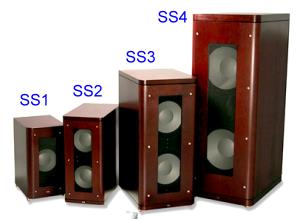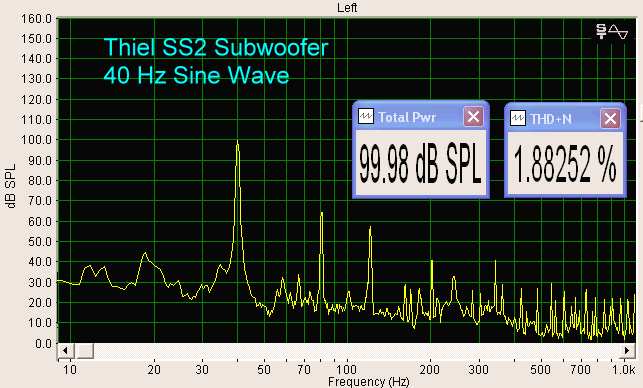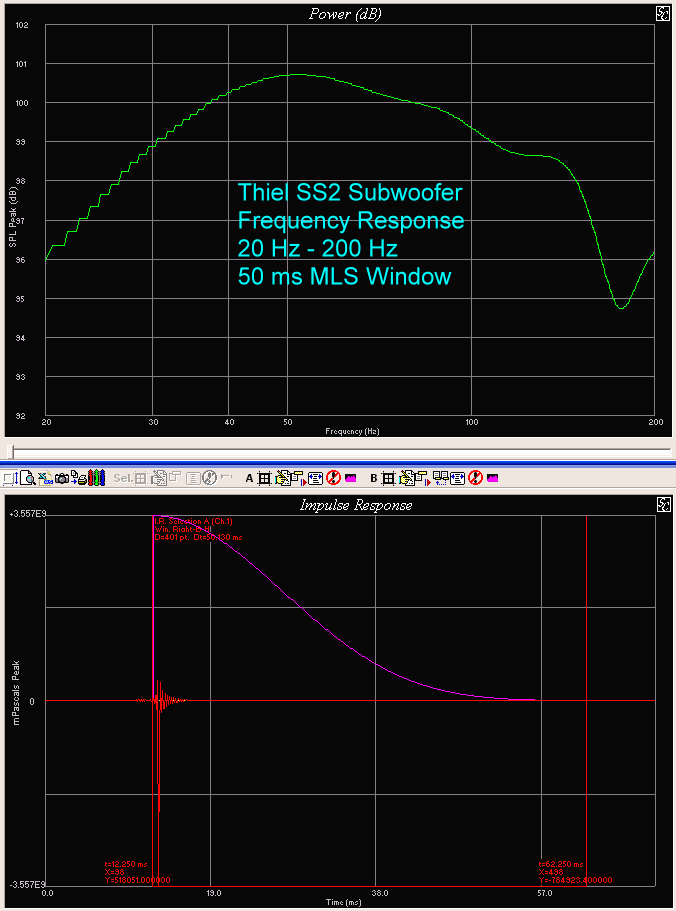|
|||||||||||||||
|
Introduction The SmartSub technology includes a microprocessor associated with the power amplifier that lets you dial in, among other things, how far away the subwoofer is placed from rear and side walls. The SS2 is the second from the smallest in the line, having two 10" drivers. All of the SmartSubs have a 1,000 watt rms amplifier, except for the SS1, which has a 500 watt amplifier. The SmartSubs come in a variety of veneer finishes, such as Amberwood, Cherry, Maple, Oak, and Walnut. Some of the veneers have an additional charge associated. The review units arrived in Amberwood. You can also select the grille fabric color. The Design The SS2 employs long throw aluminum cone drivers that have short voice coils and long gaps. This maintains the coil within the strongest part of the magnetic field of the pole pieces, which keeps distortion as low as possible. The drivers are in a sealed enclosure which has a vertical window in front that is narrower than the drivers, but it is not considered slot-loading. The power amplifier is a digital switching design, and has thermal overload protection. The circuitry corrects for compression distortion due to heating of the voice coil during heavy use. The rear panel of the SS2 is quite complex, compared to most other subwoofers. For one thing, there are two handles for assistance in moving the enclosure around the room. It has two inputs, one of which is RCA unbalanced (called the LFE Input), and the other XLR balanced (called the Normal Input). There are also RCA and XLR outputs if you want to daisy chain to another subwoofer.
You can dial in the distance from the rear wall and side wall, as well as select the LFE input level through a series of buttons. Distances are displayed in 0.1 meter increments on a digital readout panel. A small toggle at the bottom lets you select Auto On if you want your processor to power the subwoofer on through the trigger input jack just above the toggle. There is also a main power-on rocker switch. The AC cord is grounded and detachable. Neither input passes through a crossover. The reason for this is that all modern SSP (Surround Sound Processors) and most receivers have bass management, which lets you assign the low-pass crossover frequency to the subwoofer, anywhere from 40 Hz to 200 Hz. So, generally speaking, a built-in crossover is no longer a necessity in subwoofers. If you insist on having one, Thiel supplies the PX02 (two-channel) and PX05 (five-channel) which are external boxes for this use. You can do the same thing with these external crossovers that the bass management system in SSPs can do, but the advantages of using your SSP are that you may avoid electronic phase shift if the bass management does its thing in the digital domain, and you save considerable expense (the PX02 and PX03 use very costly parts). The Listening For the tests and audition, I used my SSP's (Lexicon MC-12) low-pass crossover, and also the Thiel SmartSub Integrator SI-1, which I will address in a subsequent review. The Integrator blends the subwoofer to your main speakers, with an amazing array of features and adjustments. Other equipment for the review included a Balanced Audio Technology VK-5i preamplifier, McIntosh MC-602 power amplifier, Thiel PCS speakers, Monitor Audio Studio 20 SE speakers, Carver Mark IV ribbon speakers, and Nordost cables. I tested the SS2 in two-channel configurations. I think it goes without saying that the smaller the speaker, the more important a contribution the SS2 made. The Thiel PCS bookshelf monitor speakers, reviewed recently, which sound excellent by themselves, benefited greatly by the addition of the SS2 into the package. I crossed the signal over at 55 Hz, which is the 3 dB down point of the PCS. Second to benefit from the SS2 were the Monitor Audio speakers, followed by the Carvers, which have four 12" drivers in each speaker. Never did the SS2 sound boomy (the distortion levels seen in the bench tests are observed with sine waves, but not likely to be encountered in music or movie sound tracks). Dukas' La Peri on Erato (2292-45221-2) is one of my favorite orchestral discs, and the Fanfare is a brass lover's delight. The SS2 adds that last touch to the Thiel PCS so that the depth of the larger horns is appreciated. George Shearing's Quintet (Telarc SACD-63546) has some wonderful string bass tracks that are reproduced with a superlative flair when the SS2 is in the system.
With organ works, now you separate the grain from the chaff. For example, Liszt' Works for Organ, Volume 2 (NAXOS 8.555079) has the "Fantasy and Fugue", which is very demanding, but the SS2 easily meets the requirements. I can imagine what the SS3 and SS4 can do with this disc. RCA is re-releasing older recordings that were made in three-channels, and putting them back on store shelves in SACD form. Mussorgsky's Pictures at an Exhibition (RCA-8-28766-13942-6), originally recorded in the 1950's, still has the power and depth that it did back then, but now we have the advantage of subwoofers such as the SS2, which show off the music in a way that listeners of a half century ago probably never heard.
Reference Recordings' release, Bells for Stokowski (RR-104-CD), has some tracks that are astonishing, particularly the Tielman Susato "Selections from The Danserye". The bells that they use are extremely intense, and require speakers that can reproduce the transients. The PCS did well with this, but it took the addition of the SS2 to get the depth of the bass in the orchestra. SuperBass 2 (Telarc SACD-63483) is a jazz disc, with Ray Brown, John Clayton, and Christian McBride (recorded at the Blue Note in New York City). The tracks have incredible string bass solos. While any subwoofer can play explosions in movies, you don't really know if the sound is accurate. However, only a high performing subwoofer like the SS2 can deliver the clarity needed to reproduce string bass tracks and make them sound real.
While I have tested subwoofers with lower distortion, the SS2 has the advantage of being able to dial in such things as room settings, which other products do not have. I don't know what algorithms are involved here, but I do know that the SS2 seemed to blend with the main speakers in a way that I have rarely heard before. This was especially so when using the Thiel SmartSub Integrator. On the Bench For measurements, the microphone was placed 12" from the center of the subwoofer, on-axis. The Room Settings (adjusted on the back of the subwoofer) were 2 meters from the rear wall and 1.8 meters from the side wall. At a test signal combination of 20 Hz, 31.5 Hz, and 50 Hz, maximum SPL was 105 dB at 1 foot. At 20 Hz, THD was high, at 18% and 100 dB.
At 25 Hz, THD was still pretty high, at 11%.
By 31.5 Hz, THD was significantly lower, at 4%.
Only 2% THD was recorded at 40 Hz and 100 dB SPL.
THD was less than 1% at 50 Hz.
The quasi-anechoic frequency response was down only 4.7 dB between 50 Hz and 20 Hz, which is excellent. The room response was quite flat, using the SmartSub Integrator, which I will illustrate in the review of that product soon.
Conclusions Thiel's new SS2 SmartSub is a very innovative and great sounding subwoofer. Playing deep bass is part of its forte, but it also has settings for where you place it in your room. This helps the subwoofer blend with the main speakers. DSP with subwoofers is here to stay, and Thiel's salvo into this arena with the SmartSub line appears to be a winner.
|
|||||||||||||||

















